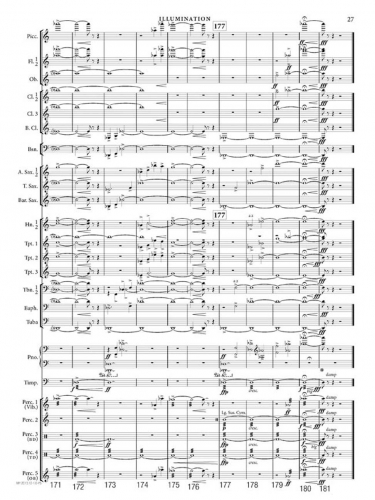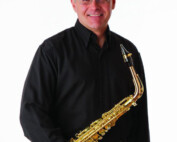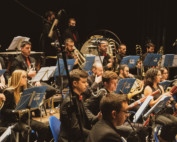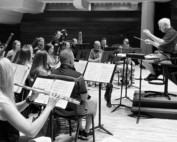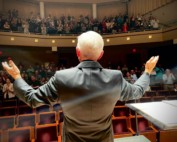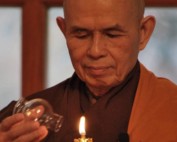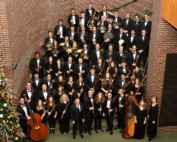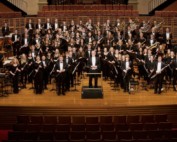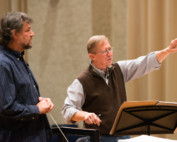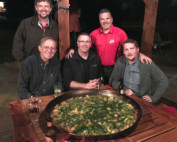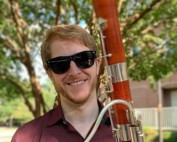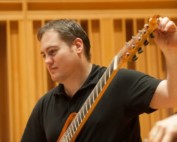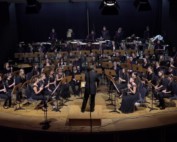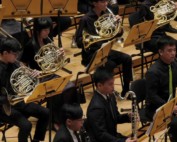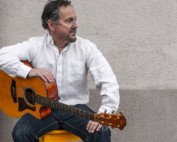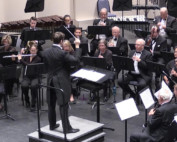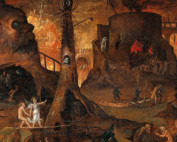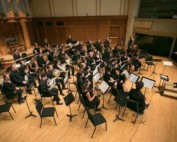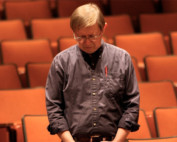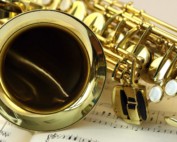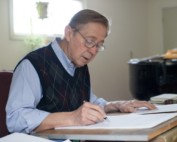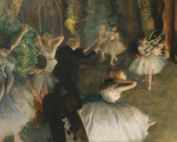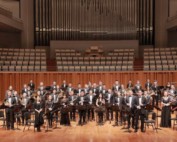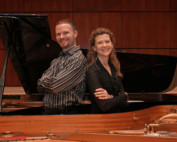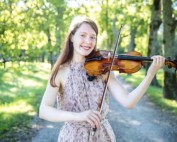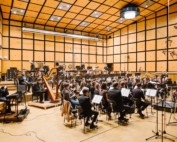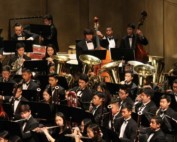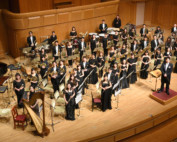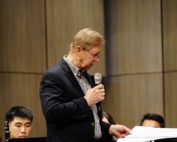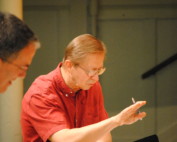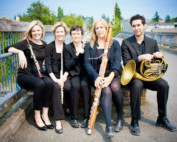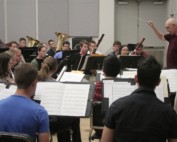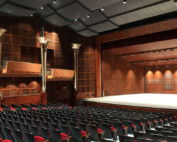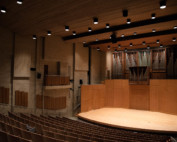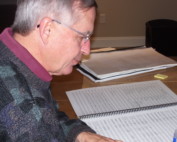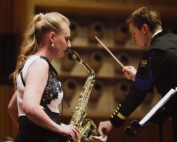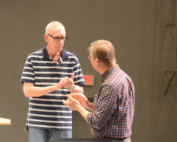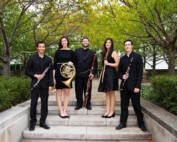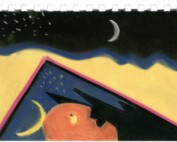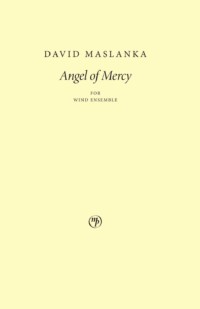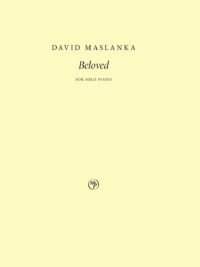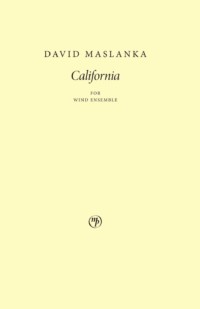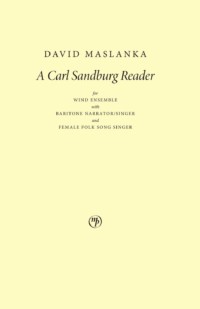Project Description
Wind Ensemble
2013
5 min.
Grade 3.5
Listen Now
Franklin High School Band, Nicole Wright, cond.
premiere performance, live recording
Lakeland College Concert Band (Sheboygan, Wisconsin), Christopher Werner, cond.
live recording, 19 November, 2014
Instrumentation
Picc Fl-2 Ob-2 BbCl-3 BCl Bsn ASx-2 TSx BSx | Hn-2 Tpt-3 Tbn-2 Tuba | Pno Timp Perc-5
- Piccolo
- Flute (2)
- Oboe (2)
- Clarinet in B♭ (3)
- Bass Clarinet in B♭
- Bassoon
- Alto Saxophone (2)
- Tenor Saxophone
- Baritone Saxophone
- Horn in F (2)
- Trumpet in B♭ (3)
- Trombone (2)
- Tuba
- Piano
- Timpani
- Required Percussion (5 players)
- Vibraphone
- Marimba
- Suspended Cymbal (lg)
- Xylophone
- Chimes
- Bass Drum
- Snare Drum
- Tenor Drum
- Orchestra Bells
- Wood Block (lg)
Difficulty Level
Appropriate for most high school ensembles (Grade 3½)
The introduction (mm. 1–10), marked ♩= 80, establishes a powerful mood for the main body of the work. The introduction employs the full resources of the ensemble with most marked with a fully-articulated fortissimo.
Section 1 (mm. 11-62), marked ♩= 160, is highly energized. It has relentlessly-driving eighth notes providing forward momentum, contrasted by more sustained lines. All ensemble members will have responsibility for both the pulsing eighth note and the sustained lines.
Section 2 (mm. 63–107) offers a mood change, though at the same tempo. This section begins in a soft, reflective state. It is characterized by a slow melody in half and whole notes in the woodwinds layered over rhythmic eighth notes in the piano. The quarter notes in the mallets support the motor in the piano. The second half of this section (starting at m. 86) follows a gradual crescendo, adds the full ensemble, and presents a full-bodied restatement of the earlier woodwind presentation, descending in tessitura and dynamically away from the apex (m. 96), returning to the reflective mood.
Section 3 (mm. 108–162) returns to the earlier energized music after reestablishing the pulsating eighth notes. Material from the second section comes back at measure 146, this time full with firm articulation.
A short coda (mm. 163–181) finishes the piece in full voice with full instrumentation.
Commission
Illumination: Overture for Band was composed for the Franklin, Massachusetts public schools. The commission was started by Nicole Wright, band director at the Horace Mann Middle School in Franklin, when she discovered that my grandnephew was in her band. The piece was initially to have been for her young players, but the idea grew to make it the center of the dedication concert at the opening of Franklin’s new high school building. Rehearsals of Illumination were actually the first musical sounds made in their fine new auditorium.
Errata
103: Cl 3 Eb, not E (transposed)
Description
Illumination is an energetic and joyous piece, written at a roughly 3+ grade level. Instrumentation is complete, but certain parts, such as oboe, bassoon, and horn are not exposed. I have graded the parts so that first are more demanding, and seconds and thirds successively easier. Illumination – light rising – coming to consciousness: performing music offers the possibility of immediate awakening, and this piece has both high good nature and a sharp wake-up quality.
Program Note
“Illumination” – lighting up, bringing light. I am especially interested in composing music for young people that allows them a vibrant experience of their own creative energy. A powerful experience of this sort stays in the heart and mind as a channel for creative energy, no matter what the life path. Music shared in community brings this vital force to everyone. Illumination is an open and cheerful piece in a quick tempo, with a very direct A-B-A song form.
Further Reading
The Saxophone Sonata V2: Steven Jordheim’s Forward
Maslanka Press has released a beautiful new edition of David Maslanka's Sonata for Alto Saxophone and Piano. Learn more -- Steven Jordheim, an early champion of the work and former teacher of saxophone at Lawrence [...]
From the Maslanka Archive – No. 40, World Premiere of Symphony No. 8
From the Maslanka Archive features media and stories of David's life and work. This week, we are excited to feature Alex Teater's signed program and tenor saxophone sheet music from the World Premiere of David's Symphony No. 8.
Maslanka Weekly: Best of the Web – No. 122, New Performances of Popular Symphonies
Maslanka Weekly highlights excellent performances of David Maslanka’s music from around the web. This week, we are excited to feature amazing new performances of three of David's most popular symphonies: Symphony No. 4, Symphony No. 7, and Symphony No. 8.
From the Maslanka Archive – No. 39, Wind Symphony Alumni Ensemble: Concert Recording
We are excited to feature a complete audio recording of the concert that took place on Friday, July 16, 2022 in Naperville, IL by Dr. Stephen K. Steele and the Wind Symphony Alumni Ensemble. This special event featured Angel of Mercy, Requiem, and Symphony No. 10 - The River of Time.
Stephen K. Steele & Wind Symphony Alumni Ensemble Perform to Thunderous Applause
Stephen K. Steele & Wind Symphony Alumni Ensemble Perform Symphony No. 10, Angel of Mercy, and Requiem in Naperville, IL on July 15, 2022 to a Standing Ovation of Thunderous Applause.
From the Maslanka Archive – No. 38, The Life & Influence of Thich Nhat Hanh
From the Maslanka Archive features media and stories of David's life and work. This week, we are excited to feature the podcast Wind & Rhythm and their new episode on David's music inspired by the late Buddhist Monk, Thich Nhat Hanh.
Maslanka Weekly: Best of the Web – No. 121, Michigan State University Bands
Maslanka Weekly highlights excellent performances of David Maslanka’s music from around the web. This week, we feature various ensembles from Michigan State University playing recent performances of David's music: Symphony No. 5, Hymn for World Peace, and Symphony No. 8.
Maslanka Weekly: Best of the Web – No. 120, Mother Earth
Maslanka Weekly highlights excellent performances of David Maslanka’s music from around the web. This week, we showcase a traditional performance, an arrangement, and a score study session of On This Bright Morning.
Maslanka Weekly: Best of the Web – No. 119, Recent Performances of On This Bright Morning
Maslanka Weekly highlights excellent performances of David Maslanka’s music from around the web. This week, we showcase three extraordinary performances of On This Bright Morning.
Maslanka Weekly: Best of the Web – No. 118, Recent Performances of Mountain Roads
Maslanka Weekly highlights excellent performances of David Maslanka’s music from around the web. This week, we showcase three extraordinary performances of Mountain Roads.
The Red Door: Clarinet Works of David Maslanka – A conversation with Jeremy Reynolds and Matthew Maslanka
This conversation is about the album The Red Door: Clarinet Works of David Maslanka (2021) Works discussed: Three Pieces (1975) Fourth Piece (1979) Little Symphony (1989) Eternal Garden (2009) Trio No. 1 (1971/2012) Trio No. [...]
Maslanka Weekly: Best of the Web – No. 117, Recent Performances of Give Us This Day
Maslanka Weekly highlights excellent performances of David Maslanka’s music from around the web. This week, we showcase three extraordinary performances of Give Us This Day.
Maslanka Weekly: Best of the Web – No. 116, Recent Performances of Symphony No. 4
Maslanka Weekly highlights excellent performances of David Maslanka’s music from around the web. This week, we showcase three recent extraordinary performances of Symphony No. 4.
Rehearsing Alex and the Phantom Band and Saint Francis: Middle Tennessee State University (Oct 2016)
In October 2016, I (Matthew Maslanka) accompanied my father to Middle Tennessee State University where I photographed and recorded his masterclasses and rehearsals. This is his rehearsal on October 25. He helped produce his final [...]
Liner Notes for David Maslanka’s Final CD
This is a portion of the liner notes for David Maslanka: Works For Wind Ensemble, his final CD. The disc will be released on January 8, 2021. Sacred Spaces By Matthew Maslanka Dr Reed Thomas makes [...]
From the Maslanka Archive – No. 37, Conor Bell’s New Dissertation on David’s Bassoon Music
From the Maslanka Archive features media and stories of David's life and work. This week, we are excited to feature Conor Bell's new dissertation on David's Bassoon Music.
From the Maslanka Archive – No. 36, Anthony Joseph Lanman’s Interview of Matthew
From the Maslanka Archive features media and stories of David's life and work. This week, we are excited to feature Anthony Joseph Lanman's interview with Matthew on his podcast, 1 Track from Matthew's home in New York, NY earlier this year.
Maslanka Weekly: Best of the Web – No. 115, New Uploads of Sonata for Alto Saxophone and Piano
Maslanka Weekly highlights excellent performances of David Maslanka’s music from around the web. This week, we feature three new uploads of the Sonata for Alto Saxophone and Piano.
From the Maslanka Archive – No. 35, Damon Talley’s Interview of David
From the Maslanka Archive features media and stories of David's life and work. This week, we are excited to feature one of David's very last interviews. In April of 2017, Damon Talley - Director of Bands at LSU - had the opportunity to sit down with David and discuss Symphony No. 4 during a residency with the LSU Wind Ensemble.
Maslanka Weekly: Best of the Web – No. 114, Schwäbisches Jugendblasorchester
Maslanka Weekly highlights excellent performances of David Maslanka’s music from around the web. This week, we feature Toni Scholl and the Schwäbisches Jugendblasorchester des Allgäu-Schwäbischen Musikbunde in a new live performance of Symphony No. 8.
From the Maslanka Archive – No. 34, Julian Velasco’s Interview of Gary Green
From the Maslanka Archive features media and stories of David's life and work. This week, we are excited to feature Julian Velasco's interview of Gary Green from the Wharton Center in East Lansing, MI from October 24, 2017.
Maslanka Weekly: Best of the Web – No. 113, Amazing New Student Performances
Maslanka Weekly highlights excellent performances of David Maslanka’s music from around the web. This week, we are excited to feature three amazing new student performances of David's music: Give Us This Day, Concerto for Alto Saxophone and Wind Ensemble, and The Seeker.
From the Maslanka Archive – No. 33, John Floridis’s Interview of David
From the Maslanka Archive features media and stories of David's life and work. This week, we are excited to feature an episode from Montana Public Radio's Musician's Spotlight featuring John Floridis interviewing David about his music and background as a composer.
Maslanka Weekly: Best of the Web – No. 112, Angels
Maslanka Weekly highlights excellent performances of David Maslanka’s music from around the web. This week, we are excited to feature three of David's works that make either direct or indirect reference to angels: Symphony No. 4, My Lady White, and Angel of Mercy.
From the Maslanka Archive – No. 32, Julian Velasco’s Interview of David – Part 2
From the Maslanka Archive features media and stories of David's life and work. This week, we are excited to feature Part 2 of Julian Velasco's interview of David from his home in Missoula, MT in 2016.
Maslanka Weekly: Best of the Web – No. 111, Freshly Uploaded to the Web!
Maslanka Weekly highlights excellent performances of David Maslanka’s music from around the web. This week, we are exited to feature new performances of three works just uploaded to the web in the past seven days: Symphony No. 10: The River of Time, Recitation Book, and Illumination.
From the Maslanka Archive – No. 31, Julian Velasco’s Interview of David – Part 1
From the Maslanka Archive features media and stories of David's life and work. This week, we are excited to feature Part 1 of Julian Velasco's interview of David from his home in Missoula, MT in 2016.
Maslanka Weekly: Best of the Web – No. 110, Images of Hell
Maslanka Weekly highlights excellent performances of David Maslanka’s music from around the web. This week, we feature three of David's works that reference Hell: Hell's Gate, A Child's Garden of Dreams, and O Earth, O Stars.
From the Maslanka Archive – No. 30, Jim Tevenan’s Interview of David
From the Maslanka Archive features media and stories of David's life and work. This week, we are excited to feature an episode from Spokane Public Radio's From The Studio featuring Jim Tevenan interviewing David about his music. The Whitworth Wind Symphony had just performed David's Symphony No. 4.
Maslanka Weekly: Best of the Web – No. 109, Lawrence University Conservatory of Music
Maslanka Weekly highlights excellent performances of David Maslanka’s music from around the web. This week, we feature three ensembles from Lawrence University Conservatory of Music in performances of David's music: Symphony No. 4, Crown of Thorns, and Tears.
From the Maslanka Archive – No. 29, David on Dreaming and the Unconscious Mind
From the Maslanka Archive features media and stories of David's life and work. This week, we are excited to feature a speech David gave on matters of dreaming and the unconscious mind before a performance of A Child's Garden of Dreams by the James Madison University Wind Symphony.
Maslanka Weekly: Best of the Web – No. 108, Keitaro Harada
Maslanka Weekly highlights excellent performances of David Maslanka’s music from around the web. This week, we feature Keitaro Harada's interviews of Scott Hagan and Kevin Michael Holzman on David's Symphony No. 10 and Symphony No. 4.
From the Maslanka Archive – No. 28, David in Rehearsal with Mike Fansler and the WIU Wind Ensemble
From the Maslanka Archive features media and stories of David's life and work. This week, we are excited to feature a video of David in rehearsal with Mike Fansler and the Western Illinois University Wind Ensemble from December 2011. The rehearsal footage captures an amazing realization of the "Doxology" from Symphony No. 4.
Maslanka Weekly: Best of the Web – No. 107, Electrifying Saxophone Performances
Maslanka Weekly highlights excellent performances of David Maslanka’s music from around the web. This week, we feature three electrifying new performances of works for saxophone: Recitation Book, Concerto for Alto Saxophone and Wind Ensemble and Sonata for Alto Saxophone and Piano.
From the Maslanka Archive – No. 27, David on Composition and the Creative Process
From the Maslanka Archive features media and stories of David's life and work. his week, we are excited to feature an interview David gave to BizMontana on matters of composition and the creative process.
Maslanka Weekly: Best of the Web – No. 106, Dances
Maslanka Weekly highlights excellent performances of David Maslanka’s music from around the web. This week, we feature three compositions in which David experiments with dance forms: Montana Music: Three Dances for Percussion, Concerto for Clarinet and Wind Ensemble, and Concerto No. 2 for Piano and Wind Ensemble.
From the Maslanka Archive – No. 26, Joseph Lulloff Performs Saxophone Concerto in Lucerne
From the Maslanka Archive features media and stories of David's life and work. This week, we are excited to feature a classic performance of the Concerto for Alto Saxophone and Wind Ensemble with Gregg Hanson leading Joseph Lulloff, Alto Saxophone and the University of Arizona Wind Ensemble from the 2001 World Association of Symphonic Bands and Ensembles (WASBE) Conference.
Maslanka Weekly: Best of the Web – No. 105, Amazing Performances from China
Maslanka Weekly highlights excellent performances of David Maslanka’s music from around the web. This week, we feature three amazing performances from China: Alex and the Phantom Band, Tone Studies, and Mother Earth.
From the Maslanka Archive – No. 25, This Is The World Recording Session
From the Maslanka Archive features media and stories of David's life and work. This week, we are excited to feature pictures from Albany Record's 2011 recording session of David's This is the World.
Maslanka Weekly: Best of the Web – No. 104, Recordings of Lesser-Known Works
Maslanka Weekly highlights excellent performances of David Maslanka’s music from around the web. This week, we feature recordings of three lesser-known works of David's: Images from "The Old Gringo," Little Symphony on the name BArnEy CHilDS, and Orpheus.
From the Maslanka Archive – No. 24, David on Matters of Tempo and Dynamics
From the Maslanka Archive features media and stories of David's life and work. This week, we are excited to feature an address David gave on matters of tempo and dynamics from a masterclass given at Illinois State University.
Maslanka Weekly: Best of the Web – No. 103, LandesJugendBlasOrchester
Maslanka Weekly highlights excellent performances of David Maslanka’s music from around the web. This week, we feature Stefan Grefig and the LandesJugendBlasOrchester in a new magnificent performance of Symphony No. 10: The River of Time, and a classic performance of Traveler.
From the Maslanka Archive – No. 23, Onsby Rose’s Symphony No. 10 Presentation
From the Maslanka Archive features media and stories of David's life and work. This week, we are excited to feature a video of Onsby Rose giving a presentation discussing the highlights from his dissertation on Symphony No. 10: The River of Time.
Maslanka Weekly: Best of the Web – No. 102, Recent Performances of Symphony No. 7
Maslanka Weekly highlights excellent performances of David Maslanka’s music from around the web. This week, we feature three recent extraordinary performances of Symphony No. 7.
From the Maslanka Archive – No. 22, University of Arizona Wind Ensemble at CBDNA (2014)
From the Maslanka Archive features media and stories of David's life and work. This week, we are excited to feature a classic performance of Requiem with Gregg Hanson and the University of Arizona Wind Ensemble from the 2014 Western/Northwestern Division CBDNA Conference.
Maslanka Weekly: Best of the Web – No. 101, Light Around the World
Maslanka Weekly highlights excellent performances of David Maslanka’s music from around the web. This week, we examine three of David’s works that make reference to light: First Light, Illumination, and On This Bright Day.
From the Maslanka Archive – No. 21, David’s Final Public Address
From the Maslanka Archive features media and stories of David's life and work. This week, we are excited to feature David's last known public address which was given at The Hartt School at the University of Hartford on May 6, 2017.
Maslanka Weekly: Best of the Web – No. 100, More New Performances of Percussion Music
Maslanka Weekly highlights excellent performances of David Maslanka’s music from around the web. This week, we feature three new outstanding performances of some of David’s works for percussion: Crown of Thorns, Hohner, and This is the World.
From the Maslanka Archive – No. 20, David at Lawrence University
From the Maslanka Archive features media and stories of David's life and work. This week, we are excited to feature pictures from David's residency at Lawrence University with Andrew Mast and the Lawrence University Wind Ensemble in 2010.
Maslanka Weekly: Best of the Web – No. 99, Even More New Performances of Chamber Music
Maslanka Weekly highlights excellent performances of David Maslanka’s music from around the web. This week, we feature three new performances of chamber works: Quintet for Winds No. 3, Song Book for Alto Saxophone and Marimba, and Sonata for Bassoon and Piano.
From the Maslanka Archive – No. 19, University of Arizona Wind Ensemble at CBDNA (2008)
From the Maslanka Archive features media and stories of David's life and work. This week, we are excited to feature a classic performance of Give Us This Day with Gregg Hanson and the University of Arizona Wind Ensemble from the 2008 Western/Northwestern Division CBDNA Conference.
Maslanka Weekly: Best of the Web – No. 98, New and Classic Recordings of David’s Symphonies
Maslanka Weekly highlights excellent performances of David Maslanka’s music from around the web. This week, we feature two new performances of favorite symphonies: Symphony No. 4, Symphony No. 7, and the recording of the premiere performance of "Allegro Molto" from Symphony No. 2.
From the Maslanka Archive – No. 18, Composer Garrett Hope’s Interview of David & Matthew
From the Maslanka Archive features media and stories of David's life and work. This week, we are excited to feature an episode from the podcast The Portfolio Composer featuring composer Garrett Hope interviewing David and Matthew about the genesis of Maslanka Press.
Maslanka Weekly: Best of the Web – No. 97, Playing in Quarantine
Maslanka Weekly highlights excellent performances of David Maslanka’s music from around the web. This week, we feature three amazing examples of how a few talented musicians have used technology to play David's music and make it available on the internet for us to enjoy.
From the Maslanka Archive – No. 17, Score Study With Stephen Steele
From the Maslanka Archive features media and stories of David's life and work. This week, we are excited to feature pictures of Stephen Steele using scores to prepare a studio recording of David's music.
Maslanka Weekly: Best of the Web – No. 96, Beautiful Solo Saxophone Performances
Maslanka Weekly highlights excellent performances of David Maslanka’s music from around the web. This week, we feature three beautiful new solo performances of works for alto saxophone: Concerto for Alto Saxophone and Wind Ensemble - Movements I and III, and Sonata for Alto Saxophone and Piano - Movement I.
From the Maslanka Archive – No. 16, Gregg Hanson’s Podcast Episode on David’s Music
From the Maslanka Archive features media and stories of David's life and work. This week, we are excited to feature an episode from the podcast Bandranting featuring Gregg Hanson and James Sepulvado discussing David's music.
Maslanka Weekly: Best of the Web – No. 95, More New Performances of Chamber Music
Maslanka Weekly highlights excellent performances of David Maslanka’s music from around the web. This week, we feature three new performances of chamber works: Quintet for Winds No. 3, Quintet for Winds No. 1, and Sonata for Oboe and Piano.
From the Maslanka Archive – No. 15, A Child’s Garden of Dreams
From the Maslanka Archive features media and stories of David's life and work. This week, we are excited to feature pictures from David's residency with Stephen K. Steele and the Illinois State University Wind Symphony for a performance of A Child's Garden of Dreams in 2012.
Maslanka Weekly: Best of the Web – No. 94, Creative Arrangements – Volume II
Maslanka Weekly highlights excellent performances of David Maslanka’s music from around the web. This week, we showcase more creative arrangements of Give Us This Day.
